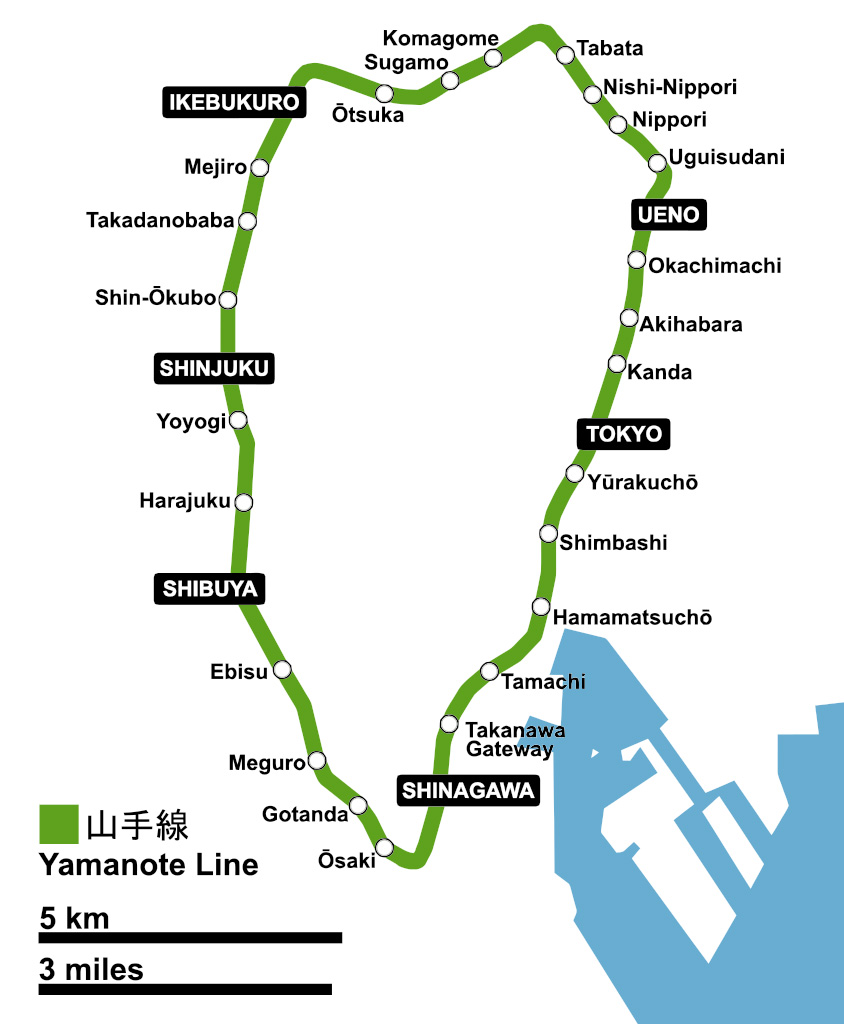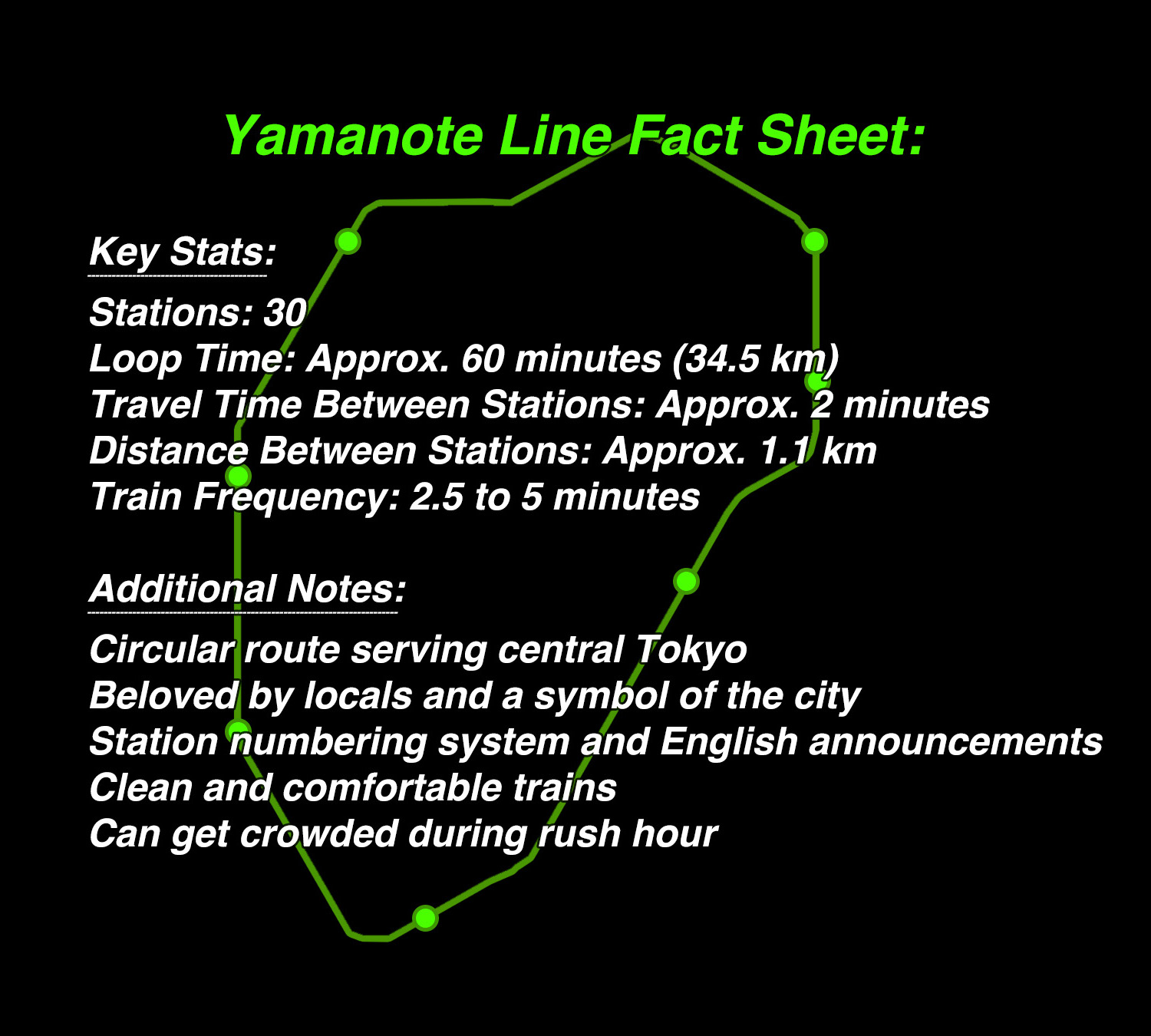Yamanote Line & Beyond: Tokyo Travel Guide

Video's Narrative
Yamanote Line & Beyond: Tokyo Travel Guide
Tokyo! A city that pulsates with neon signs, where ancient shrines and temples whisper tales of the past. Here, countless eateries tempt your taste buds with a symphony of flavors. It is a place where ancient traditions meet neon-lit excitement. Close your eyes and picture yourself in the heart of this dazzling metropolis. But beneath the dazzling surface lies a complex transportation network, a bustling labyrinth carrying millions of commuters and visitors daily! Just imagine that stations like Shinjuku see a staggering 3.6 million passengers pass through their doors daily, followed by Shibuya with 3.0 million, Ikebukuro with 2.5 million, and Tokyo Station with 1.1 million! In fact, the Yamanote Line boasts not only the top three world's busiest stations (Shinjuku, Shibuya, and Ikebukuro) but a total of nine stations within the world's busiest stations’ top 20 in the loop. Feeling a little overwhelmed? Don't worry! The Yamanote Line is the key to navigating Tokyo safely and efficiently, and this video will be your guide to unlocking its secrets!

Now that you're familiar with the basics - let’s explore what makes the Yamanote Line so user-friendly. The Yamanote Line has a convenient station numbering system. With your understanding of Japan Rail's efficient numbering system, navigating the rail system in the Tokyo metropolitan area may become easier. The Yamanote Line, for instance, is represented by the alphanumeric code 'JY.' Stations follow a 2-letter code plus numbers pattern, with Tokyo Station often labeled as '01' for many lines, but not always. For instance, it's 'JY01' on the Yamanote Line and 'JK26' on the Keihin-Tohoku Line. Also, it is useful to know that Tokyo Station is 'JY01,' and Yurakucho, a station to the south, is 'JY30.' The numbering increases counter-clockwise. For example, Shinjuku is 'JY17,' and Shibuya is 'JY20.' If you are at Tokyo station and your destination is Shibuya, taking the Yamanote Line in the clockwise direction can be advisable, providing a helpful strategy to navigate Tokyo’s extensive rail network efficiently. The English announcements keep you informed about upcoming stations using this numbering system. Understanding the numbering system allows you to easily track your progress even if you don’t speak Japanese.
The Yamanote Line might be your best friend for navigating central Tokyo, but what if you want to explore a bit further afield? Enter the Keihin-Tohoku Line (JK Line)! This line stretches further south towards the vibrant city of Yokohama, famous for its charming Chinatown and bustling harbor area. It also extends north towards Urawa and Omiya, offering connections to other lines and popular destinations. But the JK Line's usefulness doesn't stop there. It also plays a complementary role to the Yamanote Line in central Tokyo.
Here's a handy tip for savvy travelers: between Shinagawa Station and Tabata Station, the JK Line actually runs parallel to the Yamanote Line (JY Line), and they often share the same platforms! This means that if your destination is between these stations, you can take either the JK Line or the JY Line.
When navigating central Tokyo, the Yamanote Line might be your best friend, but what if you arrive or depart the city? Tokyo Station (JY01) serves as a major transportation hub, especially for international travelers. While Shinjuku, Shibuya, and Ikebukuro handle more passengers overall, Tokyo Station offers connections to various destinations within and beyond the city.
1. Shinkansen Bullet Train Network: Perfect for reaching distant cities like Kyoto or Osaka quickly.
2. Narita Express: A convenient and direct train service connecting you straight to Narita International Airport.
3. Limousine Bus Services: The bus terminals are convenient and economical for reaching Narita and Haneda International Airports.Haneda.
Tokyo Station and its surrounding areas offer a variety of attractions to explore. If you want to learn more about what Tokyo Station has to offer, be sure to watch our dedicated video, "Discovering Tokyo Station - A Comprehensive Guide for Travelers." Speaking of important locations, let's start by looking at the Keiyo Line (JE), a JR line offering a convenient option for reaching Tokyo Disney Resort! The Keiyo Line takes you directly to Maihama Station (JE07), the gateway to the magic. So, if you're traveling with family or if you're a Disney fan yourself, this is the line for you!
Now, let's shift gears and explore another JR line that you can take from Tokyo - the Chuo Line (JC). While the Yamanote Line offers a scenic loop around central Tokyo, for a more direct route between Tokyo Station (JY01 - JC01) and Shinjuku Station (JY17 - JC05), consider the Chuo Line (JC Line). It connects the two stations in a more direct line, making it a time-saving option. The JC Line continues westward beyond Shinjuku, offering connections to destinations such as Nakano, Keechijohji, Mitaka, and Hahchiohji.
Interesting Fact: Speaking of Shinjuku Station, with a total of 53 platforms and over 200 exits, it holds the Guinness World Record for the busiest railway station in the world - with over 3.59 million daily passengers in 2018. No wonder navigating it can feel like an adventure, especially if you're lugging around luggage. For those who use the Shinjuku Expressway Bus Terminal, also known as Busta Shinjuku, the terminal is located right above Shinjuku Station's South Exit.
Speaking of busy stations, while Shinjuku holds the record, Shibuya Station (JY20), with its iconic scramble crossing, isn't far behind! This vibrant district, just 3 stations south of Shinjuku, is a must-visit for its trendy fashion, energetic nightlife, and youthful energy. One reason for Shinjuku and Shibuya's bustling atmosphere is the convergence of multiple transportation options. Unlike Tokyo Station, which primarily serves J R lines, Shinjuku and Shibuya Stations connect you to not only J R lines but also subways and private commuter lines. This makes it a major hub for getting around Tokyo.
Transitioning from Tokyo's bustling J R lines, the city's subway system offers a seamless way to navigate its vibrant districts. Subways like the Ginza Line connect conveniently between key districts such as Shibuya, Ohmotehsando, Akasaka-Mitsuke, Shinbashi, Ginza, Nihonbahshi, Kanda, Ueno, and Asakusa. Unlike the sprawling above-ground J R network, subway stations are mostly concealed underground, identifiable by clear signage at street-level entrances. Despite their hidden locations, these stations are strategically placed near Tokyo's popular destinations, ensuring convenient access for travelers eager to explore the city's rich tapestry of neighborhoods and attractions.
Returning to the Yamanote Line and Tokyo Station, let's delve into their vital connections and accessibility across Tokyo's bustling landscapes and beyond. The summary sheet highlights Tokyo Station's extensive network and accessibility.
(Tokyo Station Summary Sheet)Now, let's explore the accessibility of three major stations along the Yamanote Line: Shinjuku, Shibuya, and Ikebukuro. Each summary will detail their connecting lines and key destinations.
(Three Stations Summary Sheets)Shinjuku Station, renowned as the world’s busiest railway hub, serves as a pivotal interchange in Tokyo. It connects multiple J R lines, including the Yamanote, Chuo, and Sobu Lines, and private lines like the Odakyu and Keio Lines. Shinjuku Station provides direct access to vibrant nightlife, shopping districts, and entertainment venues in Shinjuku and western Tokyo. Its extensive underground facilities ensure a seamless travel experience, allowing travelers to explore both the bustling city center and the vibrant neighborhoods of western Tokyo.
Shibuya Station, with its iconic scramble crossing, is a cultural and fashion hub in Tokyo. The station connects the J R Yamanote Line, Saikyo Line, Shonan-Shinjuku Line, Tokyo Metro, and private lines such as the Tokyu Toyoko Line and Inokashira Line to Kichijoji. It offers convenient access to popular areas like Harajuku and Omotesando and features numerous shopping malls, dining options, and entertainment venues. It serves as a gateway to both central Tokyo and the fashionable districts of western Tokyo.
Ikebukuro Station is a major transport hub in northwest Tokyo, linking the J R Yamanote Line, Saikyo Line, and Shonan-Shinjuku Line with private lines such as the Tobu Tojo Line and Seibu Ikebukuro Line. Known for its bustling shopping districts and entertainment complexes like Sunshine City, Ikebukuro provides convenient access to central Tokyo and suburban areas. Its strategic location makes it an ideal starting point for exploring diverse attractions throughout the city, including the dynamic neighborhoods of western Tokyo.
In addition to Shinjuku, Shibuya, and Ikebukuro, other key stations along the Yamanote Line, such as Shinagawa, Shimbashi, Akihabara, and Ueno, also play crucial roles in Tokyo’s transportation network. While these stations might have fewer connecting lines compared to the major hubs, they still offer significant connectivity and serve as vital access points to various parts of the city. Each of these stations provides unique connections and accessibility, ensuring travelers can navigate Tokyo's extensive and efficient railway system with ease.
Generally, staying in hotels outside the Yamanote Line can offer better value for your money when visiting Tokyo. With a solid understanding of Tokyo's efficient transportation network, navigating from these areas is straightforward. Whether exploring historic districts like Asakusa and Ueno, enjoying modern attractions in Odaiba and Toyosu, or venturing to scenic Kamakura, strategic use of Tokyo's trains and subways ensures seamless travel. It's a smart strategy for those looking to save on accommodation without compromising on access to Tokyo's vibrant sights and experiences.
I hope this journey has shed light on Tokyo's intricate yet efficient transportation system. From the iconic Yamanote Line that encircles the heart of the city to the myriad of subway lines connecting every corner, Tokyo's transport network is a marvel of convenience and accessibility. Whether you're navigating bustling stations like Shibuya or exploring serene neighborhoods like Kamakura, understanding these routes opens doors to endless possibilities in this dynamic metropolis. Embrace Tokyo's transportation and let it guide you through a tapestry of experiences that define this incredible city. Thank you for joining us on this immersive journey. Stay safe until we meet again in the next episode.
